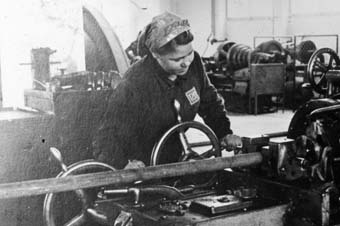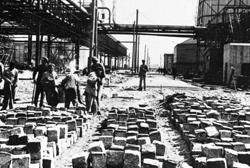Forced Labor at I.G. Farben

© Fritz Bauer Institute (Zahn papers)

© Fritz Bauer Institute
The deployment of forced laborers became a staple of the German Reich war economy by 1942 at the latest. The German Reich had been suffering labor shortages since at least late 1937. By then construction workers were in high demand at I.G. Farbenindustrie’s major building sites, the new Buna and synthetic fuel plants. Because of the relatively low wages in the chemicals industry, many of the most experienced personnel at the main I.G. factories had begun to wander off to the booming metal-working and heavy industries. In efforts to counteract the trend, I.G. plant managers turned to Carl Krauch, the former board member acting as the Reich “General Plenipotentiary for Special Questions of Chemicals Production.” and won his agreement for a rise in the working week to 56 hours, and for sending company recruiters to newly annexed territories. The first columns of “foreign workers” (Fremdarbeiter/innen) were hired in Austria and the Sudetenland and, starting in the summer of 1939, also in the “Protectorate of Bohemia and Moravia.” The I.G. managers furthermore made use of the Reich’s “Service Duty” decree of June 22, 1938, which drafted Germans as workers, and a related series of decrees issued by the “work deployment” unit of the Four-Year Plan Agency. These decrees imposed progressive limits on wage workers’ remaining rights, and obligated the first of the Germans drafted for “service duty” to remain at their workplaces. Starting in 1940, the I.G. set up a “Liaison Office W” (for Wehrmacht) in Berlin to acquire foreign civilian workers, prisoners of war, and forced laborers. After March 1942, I.G. worked with Fritz Sauckel, the newly-appointed Reich “Plenipotentiary for the Labor Deployment” who oversaw a massive expansion of the forced labor program. Individual I.G. plants also conducted their own recruitment of laborers in the occupied territories, or established temporary manpower companies and reached agreements with recruitment subcontractors.
The broad and multi-tracked recruitment methods led to enormous differences among the personnel, depending on labor law, social and “racial” policies, and country of origin, which cannot be summed up by terminological oppositions like “foreign laborers—forced laborers” or “Germans—foreigners.” The steeply graduated hierarchy of categories implemented by the I.G. headquarters for personnel data in Leverkusen divided the various worker groups according to a set of both simple and complex properties. Distinctions affecting rights and conditions of labor among the German personnel were made between men and women, and regular employees as opposed to drafted workers or those on leave from the armed forces. Distinctions were also made between workers for German companies as opposed to foreign companies, and between German and foreign contract laborers. Prisoner-laborers were separated into judicial prisoners, military prisoners, and concentration camp inmates. The usual national characterization patterns of Nazi racial ideology were applied to prisoners of war and civilian foreign workers. Among the foreign workers, only the Poles were explicitly labeled as forced laborers. This was an arbitrary usage, since many plants made use of “Ostarbeiter” (“eastern workers”), most of whom were young people drafted by force in the occupied territories of the Soviet Union. While the Western European and Italian workers (acquired by way of temporary manpower services, recruitment by third-party firms, or individual recruitment) received better treatment, this was belied by the increasingly terrible and dangerous conditions of work they also faced – and by the fact that if they attempted to leave or escape, they were subject to arrest and internment by the Sicherheitspolizei (the security police or “SiPo”) in Germany, their home countries or the occupied territories. The technical and sales cadre from the level of foreman or middle management up still received individual work contracts, but the great mass of the personnel were simply unfree.
In the final years of the war, sprawling residential camp complexes were set up in the vicinity of all I.G. Farben plants. Separate camps were maintained for the German service-draft workers and for each of the even less free categories of foreigners, prisoners of war, and Eastern European forced laborers, as well as for the “satellite commandos” of forced laborers taken from the concentration camp (KZ) system. By February 1943, fully one-half of all I.G. personnel were kept in these factory camp agglomerations. At that point the I.G. plant camp system had been expanded to hold 108,593 places for 70,543 “foreign workers,” 19,958 Germans, 14,156 prisoners of war, 2,195 military prisoners, and 1,741 other workers.
This census did not include the concentration camp inmates organized in satellite “labor commandos.” The KZ Buna/Monowitz camp with its 1,700 prisoners, opened in October 1942 at the I.G. Auschwitz plant complex, was the beginning. Based on the most current research, a total of 51,445 prisoners of the KZ system and the Gestapo were used as forced laborers starting in 1942 in at least 23 locations of I.G. Farben and its many holding company subsidiaries. Their chances of survival varied greatly. The company managements practiced every conceivable stage of exploitation, right up to the unscrupulous consumption of their labor capital. The number of prisoners who succumbed to the conditions or were killed outright at I.G. Farbenindustrie or its subsidiaries varies in the literature, depending most of all on differing estimates of deaths at KZ Buna/Monowitz. If we use the most conservative estimate of at least 10,000 dead at the Buna/Monowitz concentration camp (cited from Polish historian Piotr Setkiewicz and based on his evaluation of incompletely preserved contemporary sources), then at least 16,500 KZ prisoners died while in deployment for I.G. Farbenindustrie, representing about one-third of all forced laborers used by the combine. Other historians, among them Peter Hayes, Raul Hilberg, and Bernd Wagner, arrive at different estimates based on the statements of surviving “prisoner functionaries” who were charged with keeping the personnel index at KZ Buna/Monowitz. They estimate that between 23,000 and 25,000 prisoners were either killed by the authorities or died from hunger, disease or exhaustion just at Buna/Monowitz and the associated I.G. Farbenindustrie construction site, raising the total number of dead to 31,500 to 33,500. The personnel numbers at I.G. Farben’s approximately 100 construction and production sites reached their high point in the fall of 1944. At that time, 24,050 Gestapo and KZ prisoners were deployed to I.G. plants or organized in “labor commandos” at satellite KZ camps reserved exclusively for I.G. Farben.
(GK; transl. NL; based on: Karl Heinz Roth: Die I.G. Farbenindustrie AG im Zweiten Weltkrieg)
















